- BOAT OF THE YEAR
- Newsletters
- Sailboat Reviews
- Boating Safety
- Sails and Rigging
- Maintenance
- Sailing Totem
- Sailor & Galley
- Living Aboard
- Destinations
- Gear & Electronics
- Charter Resources


C&C 101
- By Herb McCormick
- Updated: November 1, 2013
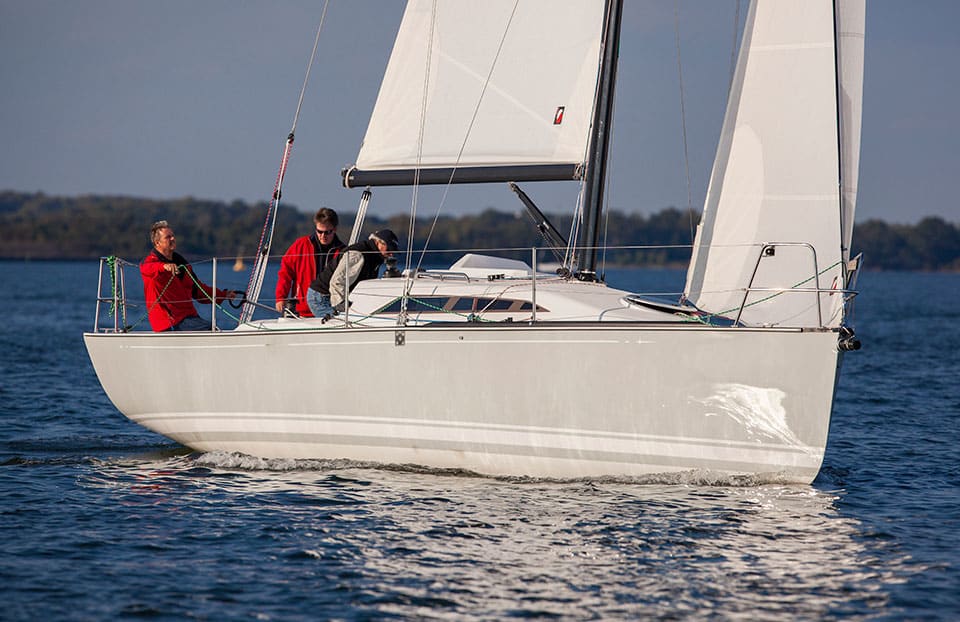
C&C 101
The dual-purpose, 33-foot racer/cruiser from C&C, which earned top honors as Domestic Boat of the Year and Best Performance Cruiser in Cruising World’s 2013 Boat of the Year awards. (See “ 9 Top Sailboats for 2013. “)
Designed by Tom McNeill, the 101 easily has the sportiest, most contemporary appearance of this troika, and thanks to its greater length and beam (almost 11 feet), also the grandest interior volume. In form and function, McNeill said the boat is “a throwback to the heyday of C&C,” when the company made its name with an almost endless series of winning club racers that were also more-than-adequate coastal cruisers. Countless sailors found the simple formula irresistible.
Thanks largely to a vast cockpit, an open transom, a lanky double-spreader carbon rig, and a no-nonsense, 6-foot-6-inch fin keel that terminates with a big lead ballast bulb, the BOTY judges believed that the 101 leaned strongly toward the “racer” end of the versatility spectrum. The adjustable sheet leads, Harken hardware package, wide traveler, and extended bowsprit for setting downwind sails underscore that notion. The entire topside layout is clean and functional—there isn’t so much as a splinter of wood in sight—and organized for six competitive sailors to take care of serious business on the racecourse.
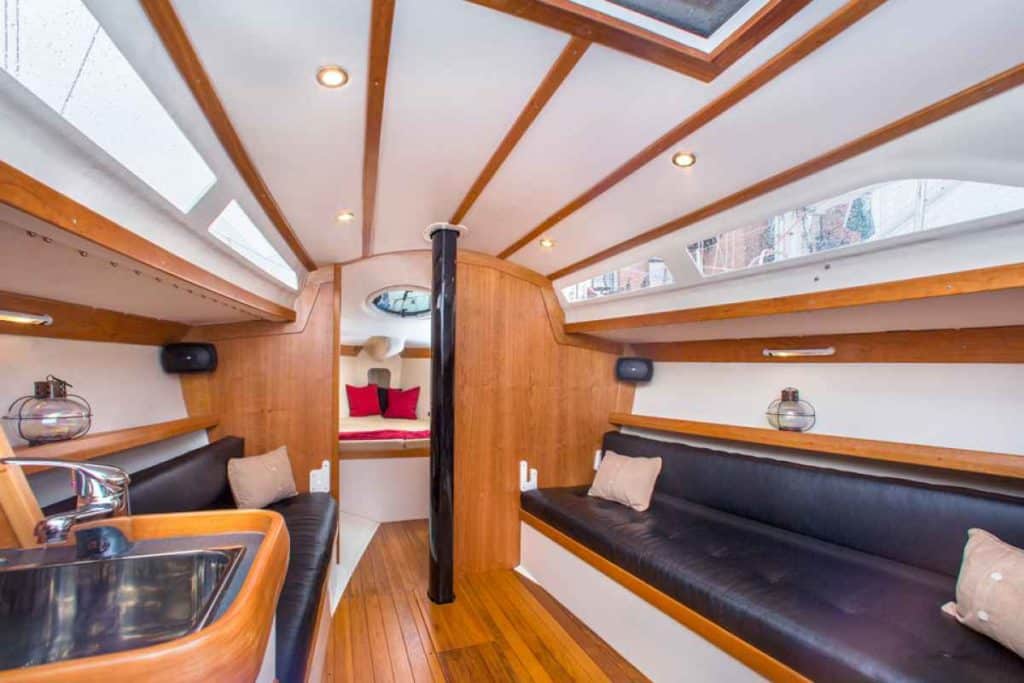
That said, when the finish gun sounds and the sails are furled, down below, creature comforts await. With generous 6-foot-6-inch headroom, there’s an unusual aura of spaciousness for a boat measuring less than 35 feet. The time-honored layout includes a private cabin forward (with enclosed head), long settees amidships (with clever, removable seat backs that flip around and can be locked inboard to serve as cushioned lee boards), and a pair of huge quarter berths aft situated beneath the cockpit. There’s also a serviceable galley and navigation station. All in all, the open, accessible berths would be fine for a racing crew for regatta week or small families on an extended summer cruise.
Of course, these days C&Cs are built alongside Tartans, and the composite construction details are absolutely top-notch. The epoxy-infused hull and deck employ a synthetic core in the former and balsa in the latter: The end result is a structure that’s both extremely light (displacement is a mere 8,838 pounds) and stiff. With the exception of the plywood bulkheads, solid wood is used for the cherry furniture and the teak cabin sole. With a base price of $175,000, that’s a lot of boat for the bucks.
But where it all comes together is under sail. A wheel is optional, but the standard tiller with extension is pretty ideal. When we sailed upwind on Chesapeake Bay in about 12 knots of breeze, boat speed was an impressive 8.2 knots. With the asymmetric kite set in a tad more wind, we’d expect to see plenty of double-digit figures. What more could you ask for in 33 feet? Not much.
Specifications
| LOA | 33′ 0″ (10.06 m.) |
| LWL | 29′ 10″ (9.09 m.) |
| Beam | 10′ 11″ (3.33 m.) |
| Draft | 6′ 6″ (1.98 m.) |
| Sail area | 671 sq. ft. (62.3 sq. m.) |
| Ballast | 3,350 lb. (1,520 kg.) |
| Displacement | 8,338 lb. (3,782 kg.) |
| Ballast/D | 0.40 |
| D/L | 140 |
| SA/D | 26.1 |
| Water | 32 gal. (121 l.) |
| Fuel | 20 gal. (76 l.) |
| Holding | 12 gal. (45 l.) |
| Mast height | 55′ 0″ (16.76 m.) |
| Engine | 18-hp Volvo Penta |
Tom McNeil C+C Yachts (440) 392-2628 www.c-cyachts.com
Herb McCormick is CW’s senior editor.
- More: 2011+ , 21 - 30 ft , Boat of the Year , c & c yachts , monohull , racer / cruiser , Sailboat Reviews , Sailboats
- More Sailboats

For Sale: 1998 Hinckley 51

Sailboat Review: HH Catamarans HH44

Sailboat Preview: 2 Sportboats We Love

Sailboat Preview: Windelo 50 Yachting

Fatty Goodlander: Where I Fall Short as Skipper

For Yachts or Home, Teak Stands the Test of Time

Shaft Bearing Maintenance Tips

- Digital Edition
- Customer Service
- Privacy Policy
- Email Newsletters
- Cruising World
- Sailing World
- Salt Water Sportsman
- Sport Fishing
- Wakeboarding
- Types of Sailboats
- Parts of a Sailboat
- Cruising Boats
- Small Sailboats
- Design Basics
- Sailboats under 30'
- Sailboats 30'-35
- Sailboats 35'-40'
- Sailboats 40'-45'
- Sailboats 45'-50'
- Sailboats 50'-55'
- Sailboats over 55'
- Masts & Spars
- Knots, Bends & Hitches
- The 12v Energy Equation
- Electronics & Instrumentation
- Build Your Own Boat
- Buying a Used Boat
- Choosing Accessories
- Living on a Boat
- Cruising Offshore
- Sailing in the Caribbean
- Anchoring Skills
- Sailing Authors & Their Writings
- Mary's Journal
- Nautical Terms
- Cruising Sailboats for Sale
- List your Boat for Sale Here!
- Used Sailing Equipment for Sale
- Sell Your Unwanted Gear
- Sailing eBooks: Download them here!
- Your Sailboats
- Your Sailing Stories
- Your Fishing Stories
- Advertising
- What's New?
- Chartering a Sailboat
- Cruising Yachts 35' to 40'
The C&C 36 Sailboat Specs & Key Performance Indicators
The C&C 36, an aft-cockpit sloop, was designed and built in Canada by C&C Yachts.
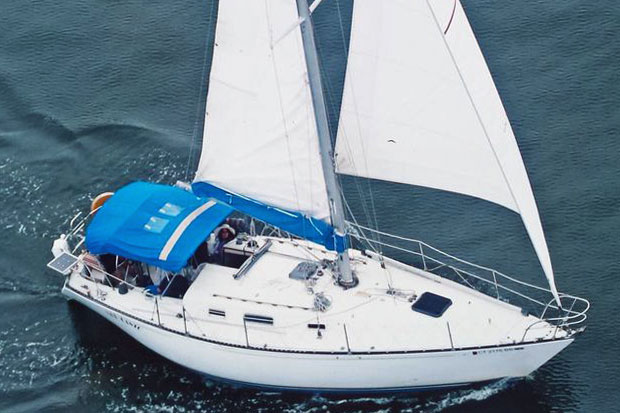
Published Specification for the C&C 36
Underwater Profile: Fin keel & spade rudder
Hull Material: GRP (Fibreglass)
Length Overall: 35'7" ( 10.9m)
Waterline Length: 27'9" ( 8.5m)
Beam: 11'6" ( 3.5m)
Draft: 5'11" ( 1.8m)
Rig Type: Sloop
Displacement: 12,000lb (5,443kg)
Designer: Cuthbertson & Cassian Ltd
Builder: C&C Yachts (Canada)
Year First Built: 1977
Published Design Ratios for the C&C 36
1. Sail Area/Displacement Ratio: 18.4
2. Ballast/Displacement Ratio: 41.7
3. Displacement/Length Ratio: 251
4. Comfort Ratio: 23.8
5. Capsize Screening Formula: 2.0
read more about these Key Performance Indicators...
Summary Analysis of the Design Ratios for the C&C 36
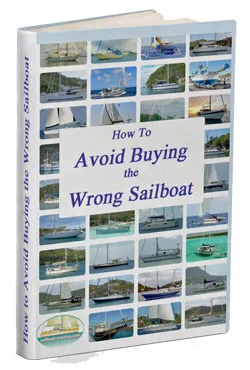
1. A Sail Area/Displacement Ratio of 18.4 suggests that the C&C 36 will, in the right conditions, approach her maximum hull speed readily and satisfy the sailing performance expectations of most cruising sailors.
2. A Ballast/Displacement Ratio of 41.7 means that the C&C 36 will stand up well to her canvas in a blow, helping her to power through the waves.
3. A Displacement/Length Ratio of 251 tells us the C&C 36 is a moderate displacement cruiser, which means she'll carry all your cruising gear without it having a dramatic effect on her performance. Most of today's sailboats intended for offshore cruising fall into this displacement category.
4. Ted Brewer's Comfort Ratio of 23.8 suggests that crew comfort of a C&C 36 in a seaway is similar to what you would associate with the motion of a coastal cruiser with moderate stability, which is not encouraging news for anyone prone to seasickness.
5. The Capsize Screening Formula of 2.0 tells us that a C&C 36 would not be as good a choice of sailboat for ocean passage-making, owing to the increased risk of capsize in strong winds and heavy seas, when compared to a sailboat with a CSF of less than 2.0.
More about the C&C 36 Sailboat...
The C&C 36 is a 10.9 m (36 ft) monohull sailboat designed by C&C Design and built by C&C Yachts starting in 1977 . It is a sloop-rigged boat with a fin keel and a spade rudder. It has a fiberglass hull and deck, with a balsa core for stiffness and insulation. The boat has a sleek and elegant profile, with a reverse transom and a low cabin top. The boat is well balanced and responsive, with good performance in light to moderate winds. The boat can accommodate up to six people in two cabins and the main salon.
Accommodation The C&C 36 has a spacious and comfortable interior, with plenty of natural light and ventilation. The boat has a traditional layout, with a V-berth cabin forward, followed by a head compartment with a marine toilet and a shower. The main salon has two settees that can convert into berths, a folding dining table, and ample storage space. The galley on the port side, comprising a stove with an oven, plus a sink and a refrigerator. The navigation station is opposite the galley, with a chart table, an electrical panel, and an instrument console. The aft cabin is accessed through the galley or the cockpit, and has a double berth and a hanging locker.
Hull and Deck The C&C 36 has a solid fiberglass hull with a balsa core sandwich construction for the deck. The hull has a moderate freeboard and a fine entry, with a flared bow that helps to reduce spray. The deck has molded nonskid surfaces for safety and traction. The cockpit is large and comfortable, with high coamings and wide seats. The boat is steered by a pedestal-mounted wheel. The boat has two large cockpit lockers for storage, as well as an anchor locker at the bow. The boat has stainless steel stanchions and lifelines, as well as bow and stern pulpits for security. The boat has an aluminum toe rail that runs along the deck edge.
Mast and Rigging The C&C 36 has an aluminum mast that is keel-stepped. The mast has two sets of spreaders and an air draft of about 15 m (49 ft). The mast supports a sloop rig with a mainsail and a furling genoa. The mainsail has slab reefing and is controlled by a traveler mounted on the cabin top. The genoa has roller furling and is sheeted to tracks on the side decks. The boat also has an optional spinnaker for downwind sailing. The boat has stainless steel wire standing rigging and dacron running rigging. The boat has two primary winches on the cockpit coamings for the genoa sheets, two secondary winches on the cabin top for the halyards and reefing lines, and one mainsheet winch on the pedestal.
Keel and Rudder The C&C 36 has a cast iron fin keel that provides stability and performance. The keel has a draft of 1.8 m (5.9 ft) and a ballast of 2,268 kg (5,000 lb). The keel is bolted to the hull with stainless steel bolts. The rudder is internally mounted on the transom and connected to the wheel by cables. The rudder is balanced and provides good steering control.
The above text was drafted by sailboat-cruising.com using GPT-4 (OpenAI’s large-scale language-generation model) as a research assistant to develop source material; we believe it to be accurate to the best of our knowledge.
Other sailboats in the C&C range include:
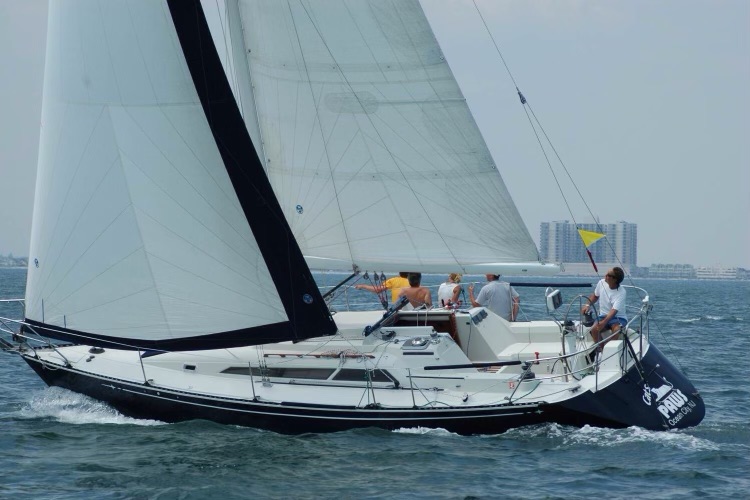
Recent Articles
The Brewer 44 Sailboat
Jun 28, 24 03:21 AM
Used Sailing Equipment For Sale
Jun 14, 24 03:54 AM
Beneteau Oceanis 473 Clipper for Sale
Jun 13, 24 11:13 AM
Here's where to:
- Find Used Sailboats for Sale...
- Find Used Sailing Gear for Sale...
- List your Sailboat for Sale...
- List your Used Sailing Gear...
Our eBooks...

A few of our Most Popular Pages...

Copyright © 2024 Dick McClary Sailboat-Cruising.com
- New Sailboats
- Sailboats 21-30ft
- Sailboats 31-35ft
- Sailboats 36-40ft
- Sailboats Over 40ft
- Sailboats Under 21feet
- used_sailboats
- Apps and Computer Programs
- Communications
- Fishfinders
- Handheld Electronics
- Plotters MFDS Rradar
- Wind, Speed & Depth Instruments
- Anchoring Mooring
- Running Rigging
- Sails Canvas
- Standing Rigging
- Diesel Engines
- Off Grid Energy
- Cleaning Waxing
- DIY Projects
- Repair, Tools & Materials
- Spare Parts
- Tools & Gadgets
- Cabin Comfort
- Ventilation
- Footwear Apparel
- Foul Weather Gear
- Mailport & PS Advisor
- Inside Practical Sailor Blog
- Activate My Web Access
- Reset Password
- Customer Service

- Free Newsletter

Pearson 37 and 37-2 Used Boat Review
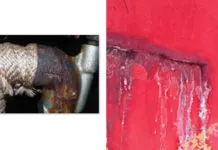
DIY Survey Checklist for Used-Boat Buying

Valiant 40: Reshaping the Cruising Hull
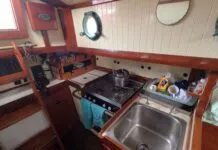
Bristol Channel Cutter 28: Circumnavigator’s Choice

Best Crimpers and Strippers for Fixing Marine Electrical Connectors

Thinking Through a Solar Power Installation

How Does the Gulf Stream Influence our Weather?

Can You Run a Marine Air-Conditioner on Battery Power?

Practical Sailor Classic: The Load on Your Rode

Anchor Rodes for Smaller Sailboats

Ground Tackle Inspection Tips

Shoe Goo II Excels for Quick Sail Repairs
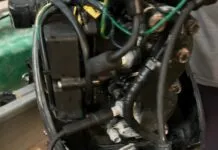
Dinghy Outboard Diagnostics
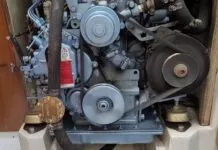
Spring Season Engine Start-Up for Winterized Engines
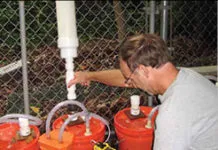
Solutions for a Stinky Holding Tank
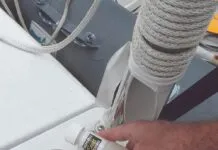

Diesel Performance Additives

Vinyl Boat Lettering DIY Application and Repair

Those Extras you Don’t Need But Love to Have
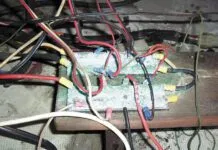
Hidden Maintenance Problems: Part 3 – Gremlins in the Electrics

Three-Model BBQ Test
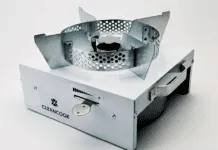
Alcohol Stoves— Swan Song or Rebirth?

Living Aboard with an Alcohol Stove

Preparing Yourself for Solo Sailing

How to Select Crew for a Passage or Delivery

Preparing A Boat to Sail Solo

Re-sealing the Seams on Waterproof Fabrics

Chafe Protection for Dock Lines

Waxing and Polishing Your Boat

Reducing Engine Room Noise

Tricks and Tips to Forming Do-it-yourself Rigging Terminals

Marine Toilet Maintenance Tips
- Sailboat Reviews
The Dual-Purpose C&C 33 Mark II
The old new c&c 33 proves to be a formidable racer that can also deliver you over the horizon..

Photos by Otto Rascon
When the C&C company shut down operations in 1986, it was big news in the North American boating community. Since the companys formation in 1969, it had been a stalwart of the industry-the leading Canadian builder, by far, and one of the major brands wherever fiberglass sailboats raced or cruised.
C&Cs lineup always featured the dual-purpose racer-cruiser, and always aimed for quality construction and detail, fitting a market niche below the outstanding luxury yacht but above the standard, midline fiberglass auxiliary. C&C boats are know for good-looking moderate designs, a tradition started by the original partners-the two Cs, George Cuthbertson and George Cassian-and the companys chief designer, Rob Ball. Performance also was a C&C hallmark. Most of its models were heavily marketed as serious racers, and even old C&Cs continue to be actively raced in PHRF fleets today. (For example, there were 14 registered to compete in the 2015 Chicago to Mackinac Race.)
C&C was the first major company to commit to cored hull construction, and only Tillotson-Pearson compared to C&C in terms of experience with balsa-cored laminates. The builder also was the first major company to commit to solid rod rigging, and they had a tradition of rigging and equipping their boats with first-class spars and fittings.
The C&C 33 is often referred to as the new C&C 33 or the C&C 33 Mark II (33-2), to distinguish it from the C&C 33 Mark I, which was produced between 1974 and l977. While some of the specs are similar, the Mark II is an entirely different boat, not sharing any of the tooling of the Mark I. The Mark I was widely regarded as one of the prettiest racers around, and 209 of them were built.
In design, the C&C 33 Mark II has conservative lines. Like other C&C models, it has a flat sheer, sharply reversed transom and sharply angled bow. The hull has a fine entry and cutaway forefoot. Theres a hard turn to the bilge about a foot below the waterline, and the very center of the hull is flat. A fin keel was the standard, but a shorter fin and a keel/centerboard combination were available options. A small skeg is fitted ahead of the spade rudder. According to owners, this setup allows for precise turning in tight spaces.
The Mark II was introduced in 1984, and over 200 of them were built in the four years the boat was in production-impressive considering the companys business problems in the middle of the run, and the heavy competition in this size from American and European companies.
Construction
The Mark IIs hull construction represented a departure from typical C&C practices, in that only the forward panels of the hull are balsa cored. The rest of the hull is a conventional hand lay-up of mat and roving, with an isophthalic gelcoat and skinning resin. The 33s larger sisters (35, 38, 41, and 44) have balsa coring throughout their hulls, while the smaller sisters (30 and 27) have no coring at all in the hull.
The cored laminate offered stiffness and strength combined with light weight, and it was one of C&Cs keys to building tough, lightweight race boats that wouldnt flex too much. To achieve stiffness and strength without the coring, C&C used what they call a spider system: basically a structural framing bonded to the hull and integrated with the attachment points for the rig and keel. The hull laminate itself becomes relatively less important structurally, as the frame becomes the primary load-bearing structure of the boat.
The deck is one-piece molding with balsa core in the horizontal surfaces, and hardware is backed with both aluminum and Coremat for strength in the attachment points.
The hull-to-deck joint is standard, with an inward-turning hull flange on which the deck is set. Stainless bolts run through the joint and through an aluminum toerail that covers the joint. The whole stem fitting as well as the corner pieces for the toerail are the heavy aluminum castings that are traditional on C&C boats, but it is interesting that C&C used plastic moldings for the stanchion bases on the 33.
When new, the Mark IIs had good quality gelcoat and generally fair hulls. But if youre considering buying a used one, be sure to look for signs of stress cracking or crazing as most of these have been raced a lot-some quite hard-over the last 25 years. Our reviewer examined one, built in 1988, that had only minor crazing and a surprisingly good quality deck, but the owner explained it had not been actively raced in the past.
The standard fin keel (6-foot, 4-inch draft) is external lead, bolted to a stub on the hull. The centerboard option is unusual in that it is a fiberglass molding with some lead inside, and the board is fitted entirely inside a shallow keel (4-foot, 4-inch draft) fitted to the hull.
The fiberglass board is lighter (for lifting) and quieter than a more common steel board, which tends to bang around in the centerboard trunk. The fiberglass molding also makes for a better-shaped and fairer fin for upwind work. The lifting cable is housed inside the keel, so it presents no drag and makes no noise at speed. The cable passes through the cabin and is housed in a stainless-steel tube, which also supports the cabin table, and is led to a stopper and winch on the aft end of the cabin house.
The fin keel weighs 3,975 pounds (42 percent of total displacement); the keel/centerboard, at 5,258 pounds, is much heavier. Nominal displacement for the fin-keel version is 9,450 pounds; for the centerboard version, its 10,733 pounds.
The 33s rudder is fiberglass over a webbing of stainless welded to the stainless-steel rudder stock. If youre considering buying a C&C 33, be sure to look over the rudder and skeg carefully.
Also, as is the case with most 25-year-old, external ballast keel boats, the ballast should be lowered and the keel bolts inspected before purchase, especially if the boat is sailed offshore. C&Cs are among the production boats (like Catalinas, Hunters, and Cals) that have been known to show a keel smile, where the keel bolts work loose and water gets in between hull and keel, causing the bolts to corrode. Usually a product of not torquing the keel bolts periodically, the keel smile is due more to a lack of proper maintenance than design.
The model that we sailed had a rig from the C&C spar shop, known in its time as a builder of sturdy high-performance rigs. The spars on later models were from Offshore Spars in Detroit.
The mast and boom are fairly heavy extrusions, painted white, with integral grooves for taking bolt rope or slugs. The mast came standard with internal halyards and lifts, as well as an internal wiring conduit and VHF cable. The boom has built-in slab reefing gear. The mast is stepped on the keel.
The standard standing rigging is made up of Navtec stainless rod, tangs, and turnbuckles, with 1 x 19 stainless for the adjustable babystay and for the split part of the lower backstay. Original main and jib halyards were stainless with rope tails. The shroud chainplates, set inboard for close sheeting, are attached to the hull by stainless rods between the deck and hull anchor points.
The Mark II came standard with good quality hardware for rig control. Spinnaker winches and gear, boom vang, and backstay adjuster were options.
Engine/Mechanical Systems
The original Yanmar 2GM engine is a bit tight in the 33s engine compartment, but otherwise the installation is first rate. The engine beds are actually part of the structural spider beams. The engine box is insulated with sound deadener, and the engine is about as quiet as you can expect a two-cylinder diesel to be. The standard solid prop should be replaced with a folding prop.
The electrical system and plumbing are well done. Electricity includes a 12-volt system with ample interior lighting. A 120-volt shore-power system, with a 50-foot shore cord, was standard equipment.
A three-burner, propane stove with oven also was standard, as was hot-and-cold pressurized water. The 30-gallon water tank is adequate for typical cruising, though ocean sailors may want to convert the standard 24-gallon holding tank to freshwater storage.
Performance
The 20-horsepower Yanmar is big enough to handle the boat in most conditions. We were under power only in fairly flat water. The boat was fitted with an optional Martek folding prop, and we had no problems backing or turning. The engine pushed the boat to hull speed easily. We suspect a big head sea would challenge the peak output of the engine, probably slowing the boat to 4 knots or so, but the amount of power is ample for all reasonable sailors in almost all conditions.
Steering is with the standard 36-inch destroyer wheel. Throttle and shift controls are integral to the pedestal, and visibility over the deckhouse is good when you are sitting on the skippers bubble hump behind the wheel.
The aluminum fuel tank holds 20 gallons, which should be good for about 180 miles of powering under normal conditions. The engine control panel is in one bay of the T-shaped cockpit. You can’t see it easily from the steering position, but thats a very minor inconvenience.
Access to the engine is through the removable companionway steps, through opening panels on both the port and starboard side of the engine, and through the cockpit seat locker.
The boat looks like it should be an all-around wholesome boat, but we initially thought of it as not particularly a standout in its size and price range. Our test sail convinced us otherwise. We found the 33-2 to be a fine sailer, just about everything we would want in its size.
The C&C 33 Mark II performs well without demanding the incessant tweaking and crew movement of so many high-performance boats. We sailed the centerboard version and evaluated a deep-keel version, and reviewers found no particular shortcomings in eithers performance.
With a good set of sails, the centerboard test boat was at least as weatherly as any boat in its PHRF division. We tried sailing the reaches and the runs with the board up and with the board down, and we could not discern any difference in speed-though as charterer, we deferred to the owners conviction that the boat was faster off the wind with the board up. The boat seemed to steer as well with the board up as with it down.
With the extra weight, the centerboard model is a little harder to push around a race course in light air, but in 15-knot winds, she had to ask no favors, and in 22-knot winds, she was a pleasure to sail compared to the other boats on the race course.
In absolute terms, we know that there are faster boats around. Most of them, unfortunately, are a pain to handle as the wind pipes up, and we wouldnt want to sail them on some of the long, rainy slogs that we often encounter in cruising. Shorthanded, most of the faster boats are miserable. The C&C 33, in contrast, is an easy sailer, respectable in light winds, and a pleasure in heavy.

courtesy of Olson’s Classic Yachts
The deck layout on the C&C 33 is conventional. The double lifelines with lifeline gates, pulpit, and pushpit are sturdy, well made, and came as standard equipment. The pushpit has a gate that can be fitted with stern ladder-a good idea for both the racer and cruiser.
The foredeck is quite narrow, so anchoring and headsail handling can be difficult. The sidedecks leading aft are wide because of the inboard shrouds and easy to move along.
Because of the sculpting and window shape, the cabinhouse looks low, but it is actually quite high-a difficult step up from the sidedecks or cockpit for some. Fortunately, because all the lines lead aft to the back edge of the cabin, theres not much occasion to walk on the cabintop abaft the mast. Forward of the mast, the cabin slopes gradually into the deck, and movement is easy. However, the skylight over the head and the forward hatch are slippery stumble-makers and need to have nonskid tape put on them.
Our test boat did not have a dodger, and the sculpting of the cabin house may make it difficult to design a wide one. A narrow dodger, fitting just over the companionway, would work well.
The cockpit is a conventional T-shape with a bridgedeck-mounted traveler. A cabintop-mounted traveler was an option, but there seems to be little to recommend it. The cockpit seats are comfortable for sitting but too short to lie down on. The forward part of the coaming is OK for sitting, but youll be inclined only to stand on the cockpit sole, aft of the bench seats. The cockpit is definitely skewed a little toward the racing side of this boats dual purpose, and its a much better cockpit underway than dockside.
Hardware is good quality and well arranged. The standard winches are of adequate size, though the boat is stiff enough to carry a heavy 150-percent genoa in 20 knots of wind, and thats a handful for the No. 24 primaries, unless the racing crew is on board.
As is the case in most boats of the 33s vintage, theres not too much abovedecks storage room. An anchor well forward will stow a Danforth, but everything else will have to go into the one aft locker under the starboard cockpit seat. Its a cavernous locker, but the serious cruiser will have to devise a way to subdivide it to make it more usable. Behind the helmsman are a small locker for propane bottles and a small stowage spot for winch handles.
The arrangements belowdecks are conventional: V-berth forward, head with shower opposite a hanging locker; port and starboard settees outboard of a saloon table; L-shaped galley; nav station at the head of a double quarterberth (well, maybe a one-and-three-quarter quarterberth). From the center bulkhead aft, the boat is wide open, which seems to us like a more sensible arrangement than the Euro compartmentalizing of the aft cabin and aft head, at least in a boat this size.
A few notable details: A decent built-in bureau in the forward cabin is a nice touch. The head compartment is a single fiberglass molding, including the wash basin-all compact, well designed, and easier to clean. The galley is quite serviceable, with a good stove and a stainless bash bar to keep you from crashing into it.
The teak overhead and bulkhead veneer contrast with the off-white hull liner. The liner is well done, with removable panels for servicing hardware fittings, wiring, and so on.
Overall, the cabin is comfortable. Weve often heard older C&Cs rapped as leaky boats, with drips around windows and under heavily loaded deck hardware, but the boat we sailed was completely dry.
Owners Comments
The biggest complaints among the C&C 33 Mark II owners that Practical Sailor surveyed were engine access and cabin ventilation. Nearly all noted that it was a challenge to access the engine easily, and most reported that their boat upgrades including increasing belowdecks ventilation with solar vents or other openings.
Interestingly, most gave the boat an average rating for stability but rated the seaworthiness as good or better. The majority of those surveyed rated the boats upwind and off-the-wind performance equally good; only a handful said the upwind performance was better.
Some things to keep in mind if youre shopping for a C&C 33: Check for leaks around the chainplates and look for stress cracking in the deck, signs the boat had a hard racing life and the backstay likely saw too much pressure. A few surveyed owners reported blisters, but both said the problem was minor. One owner cautioned others to check the transmission shaft cable as his was not installed and adjusted properly, resulting in premature clutch failure.
Conclusions
If youre entirely devoted to racing, wed probably suggest looking at something different-maybe a J/33, or possibly a J/35. For those who solely cruise, wed also recommend different boats-maybe something more like a Tartan 34 or a Mason 33. But if you plan to do a good share of racing, some serious weekending, and at least one long, shorthanded cruise per season, then the C&C 33 is among the boats we suggest checking out. Although in some ways, it seems plain and indistinctive, the C&C 33 is admirably suited to be both a racer and a cruiser. Its a boat for sailors who truly want a racer-cruiser. C&Cs also hold their value well, so buying one would be a sound investment, and there are plenty in good condition to be had on the resale market, especially in Canada.
Editors note: This review is an updated and expanded version of one previously published.
- C&C 33 Mark II Owners
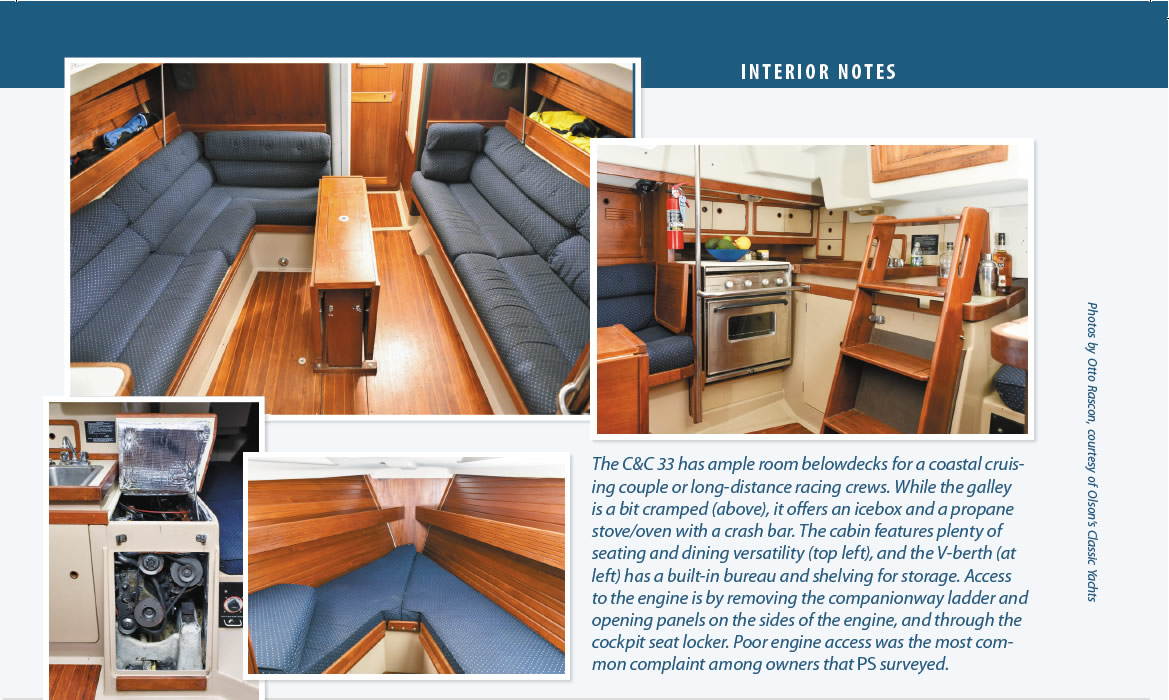
RELATED ARTICLES MORE FROM AUTHOR
Leave a reply cancel reply.
Log in to leave a comment
Latest Videos
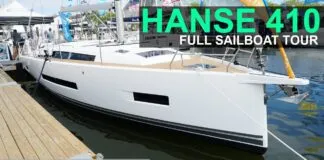
Hanse 410: What You Should Know | Boat Tour

Sailboat vs Fishing Boat – Rules of the Road

Catalina 445: What You Should Know | Boat Review

How to Wax and Polish Your Boat
- Privacy Policy
- Do Not Sell My Personal Information
- Online Account Activation
- Privacy Manager
Great choice! Your favorites are temporarily saved for this session. Sign in to save them permanently, access them on any device, and receive relevant alerts.
- Sailboat Guide
C&C 26 is a 25 ′ 7 ″ / 7.8 m monohull sailboat designed by C&C Design and built by C&C Yachts starting in 1976.

Rig and Sails
Auxilary power, accomodations, calculations.
The theoretical maximum speed that a displacement hull can move efficiently through the water is determined by it's waterline length and displacement. It may be unable to reach this speed if the boat is underpowered or heavily loaded, though it may exceed this speed given enough power. Read more.
Classic hull speed formula:
Hull Speed = 1.34 x √LWL
Max Speed/Length ratio = 8.26 ÷ Displacement/Length ratio .311 Hull Speed = Max Speed/Length ratio x √LWL
Sail Area / Displacement Ratio
A measure of the power of the sails relative to the weight of the boat. The higher the number, the higher the performance, but the harder the boat will be to handle. This ratio is a "non-dimensional" value that facilitates comparisons between boats of different types and sizes. Read more.
SA/D = SA ÷ (D ÷ 64) 2/3
- SA : Sail area in square feet, derived by adding the mainsail area to 100% of the foretriangle area (the lateral area above the deck between the mast and the forestay).
- D : Displacement in pounds.
Ballast / Displacement Ratio
A measure of the stability of a boat's hull that suggests how well a monohull will stand up to its sails. The ballast displacement ratio indicates how much of the weight of a boat is placed for maximum stability against capsizing and is an indicator of stiffness and resistance to capsize.
Ballast / Displacement * 100
Displacement / Length Ratio
A measure of the weight of the boat relative to it's length at the waterline. The higher a boat’s D/L ratio, the more easily it will carry a load and the more comfortable its motion will be. The lower a boat's ratio is, the less power it takes to drive the boat to its nominal hull speed or beyond. Read more.
D/L = (D ÷ 2240) ÷ (0.01 x LWL)³
- D: Displacement of the boat in pounds.
- LWL: Waterline length in feet
Comfort Ratio
This ratio assess how quickly and abruptly a boat’s hull reacts to waves in a significant seaway, these being the elements of a boat’s motion most likely to cause seasickness. Read more.
Comfort ratio = D ÷ (.65 x (.7 LWL + .3 LOA) x Beam 1.33 )
- D: Displacement of the boat in pounds
- LOA: Length overall in feet
- Beam: Width of boat at the widest point in feet
Capsize Screening Formula
This formula attempts to indicate whether a given boat might be too wide and light to readily right itself after being overturned in extreme conditions. Read more.
CSV = Beam ÷ ³√(D / 64)
One variant of this design was called the C&C 26 ENCOUNTER. Photo courtesy Adam Hunt.
Embed this page on your own website by copying and pasting this code.
- About Sailboat Guide
©2024 Sea Time Tech, LLC
This site is protected by reCAPTCHA and the Google Privacy Policy and Terms of Service apply.

- Forum Listing
- Marketplace
- Advanced Search
- About The Boat
- Boat Review Forum
- SailNet is a forum community dedicated to Sailing enthusiasts. Come join the discussion about sailing, modifications, classifieds, troubleshooting, repairs, reviews, maintenance, and more!
C&C 26 Impressions
- Add to quote
Check out cncphotoalbum.com.
The original 26 was part of the same series including 29 MK1 and the 34 - some of the earliest cored-hull production boats from C&C. It's a roomy boat for it's length, a bit boxy-looking compared to the standard C&C fare of the day. All three boats were said to be 'tender', but sailed well by all reports. Not sure of the difference between that 26 and the 'Encounter'... only a year apart. The 26 Wave looks to be simply a shoal draft version of the 27 MK5.. virtually identical moldings and dimensions. Late 80s offering, good looking boats with crisp molding detailing on deck. I've not heard of people claiming tenderness for that boat, but in general most C&Cs sail quite well, as I'm sure you know. Hull speeds will be similar.. that's a function of length rather than design - esp when planing is not going to be involved.
Faster, made a point about the hulls, and I checked my 'owners manual' and the 'Encounter' 26 has "Single unit moulded fiberglass, alternate layers mat and woven roving". The deck is "alternate layers hand laid up mat and roving, balsa cored". Maybe they changed things in later boats, I'll check with CnC Photoalburm, but that is what my book says. I'm thinking this is a good thing? I think she is a little tender, it doesn't take much to heel her over, but she does sail well. If under main only, a guest of about 15 will round her up, and nothing you can do to stop her, a good thing for stupid people like me who, 'THINKS' they are sailors! Look forward to hearing more about your boat.
I have a C&C 34, and while my experience is limited, I don't think of her as tender... more as spirited. I find she just likes to sail at 15-25 degrees over... almost no matter the wind speed. I had a problem of her rounding up in gusts, but now I just trim accordingly on a gusty day, and not much issue anymore. As for hull speed, I've had her above hull speed for consistent stretches, without feeling like I was on edge of control.
I like that..."spirited". C&C's traditionally are stiff boats. The construction as well as the use of the balsa helped with their frame strength and rigidty. It can be like different cars...some people love power steering...some like the feel of the road. With a C&C you will feel like you are sailing and you can respond accordingly. The tenderness is part that and part learning how to keep the boat on its feet without over trimming it or having too much sail area for conditions. While its fun to bury the rail at times, long term sailing and cruising for most on here not racing it would wear them out kept up over 6 hours time. Each boat you have the find whats its sweet spot is and how to reduce sail area and from which sail Our C&C 35 MKIII likes a full main and reefed headsail first, other boats handle differently. She is faster at 20 knots steady with a partially reefed 135 and full main, then leaving everything up and depowering or reefing the main. Different trails have taught me that. I have sailed a lot on all three of the 26 and they are fun boats. Quuality when built was good. Condition depends on the owners maintainence and upkeep program individual; for each boat. Dave
If under main only said: That doesn't sound good -- I just sold my Mirage 26 which did very well at gusts of even 20 knots ( bottom of flags curl and white caps - right?) she was her best heeled over between 15 to 25 degrees. Just bought my C&C which was dry docked and had her shipped to my Marina -was impressed by the interior space, wide decks, diesel engine and also her wheel steering. Never had her in the water and can't wait until next spring but now I feel perhaps I should have done some research before handing over the bank draft. Click to expand...
That doesn't sound good -- I just sold my Mirage 26 which did very well at gusts of even 20 knots ( bottom of flags curl and white caps - right?) she was her best heeled over between 15 to 25 degrees. Just bought my C&C which was dry docked and had her shipped to my Marina -was impressed by the interior space, wide decks, diesel engine and also her wheel steering. Never had her in the water and can't wait until next spring but now I feel perhaps I should have done some research before handing over the bank draft. Click to expand...
No, you did not waste your money, the 26 is a great boat, my rounding up is because I only sail on main alone. Everyone will tell you CnC's are well built boats! Did not mean to give you any negative feelings about the 26, I love mine, as you say it has alot of room on deck, and below.
I don't think you have anything to worry about. I'd rather have a boat that was lively enough to react to a puff than a dog that can't get out of her own way... C&C knew what they were doing. As long as all the usuals were checked/surveyed/dealt with you'll be just fine.
Thanks .. felt a bit disappointed for a while but I'm over it. Why sail with main alone? When only going out for a quick sail I sometimes only put up the fore sail because putting up the main is a bit of a hassle for me.
Ha, ha, I think the main is easy? My wife doesn't know anything about sail trim, so I try to K.I.S.S. for her. She is more of a rider than anything else. I would like to hear more owners input on the 26.
I have a C&C 24 but have never seen a 26! I have a 26 Mirage and a 27 C&C near my boat and there are many 25's but on lake St. Claire where there many C&C's the 26 is elusive! My 24 is tender but well built and fun to sail! I like my marina neighbor's Mirage 26 and had offered to buy it before I bought mine several years ago. If the C&C 26 sails like it, it!s a nice all around boat( especially with it's diesel inboard and this guy has Rolly Tasker heavy duty sails)! My other neighbor has a 82 27 C&C he bought new over $30k and is still a great boat! WhAt years were the 26's made?
- ?
- 175.1K members
Top Contributors this Month
- Скидки дня
- Справка и помощь
- Адрес доставки Идет загрузка... Ошибка: повторите попытку ОК
- Продажи
- Список отслеживания Развернуть список отслеживаемых товаров Идет загрузка... Войдите в систему , чтобы просмотреть свои сведения о пользователе
- Краткий обзор
- Недавно просмотренные
- Ставки/предложения
- Список отслеживания
- История покупок
- Купить опять
- Объявления о товарах
- Сохраненные запросы поиска
- Сохраненные продавцы
- Сообщения
- Уведомление
- Развернуть корзину Идет загрузка... Произошла ошибка. Чтобы узнать подробнее, посмотрите корзину.
Oops! Looks like we're having trouble connecting to our server.
Refresh your browser window to try again.

IMAGES
VIDEO
COMMENTS
C&C. C&C is a yacht builder that currently has 123 yachts for sale on YachtWorld, including 20 new vessels and 103 used yachts, listed by experienced yacht brokers and boat dealerships mainly in the following countries: United States, Canada, Thailand, France and Colombia. Models currently listed on YachtWorld span in size and length from 22 ...
C&C Yachts was a builder of high-performance fiberglass monohull sailboats with production facilities in Canada, Germany, and the United States. [1] C&C designed and constructed a full range of production line cruiser-racer boats, as well as custom one-off and short production run racing and cruising boats.
C&C Yachts was formed in 1969, when Canadian boat builders Belleville Marine Yard, Hinterhoeller Ltd. and Bruckmann Manufacturing joined forces with the design firm of Cuthbertson & Cassian Ltd. New capital was raised through a stock offering on the Toronto Stock Exchange. Although Ian Morch of Belleville Marine Yard was the first president, he resigned in 1971 taking the Belleville assets ...
C&C is a boat builder in the marine industry that offers boats for sale in differing sizes on Boat Trader, with the smallest current boat listed at 16 feet in length, to the longest vessel measuring in at 44 feet, and an average length of 29 feet. Boat Trader currently has 57 C&C boats for sale, including 13 new vessels and 44 used boats listed ...
C&C Yachts was formed in 1969, when Canadian boat builders Belleville Marine Yard, Hinterhoeller Ltd. and Bruckmann Manufacturing joined forces with the design firm of Cuthbertson & Cassian Ltd. New capital was raised through a stock offering on the Toronto Stock Exchange. Although Ian Morch of Belleville Marine Yard was the first president, he ...
Find Sail C&C Yachts for sale in your area & across the world on YachtWorld. Offering the best selection of C&C Yachts to choose from. ... 1970 C&C 35 Mk I. US$17,000. Boat Brokers LKN | Mooresville, North Carolina. Request Info; New Arrival; 1976 C&C 30 MK1. US$14,238. MARINE 360 - CANADA | Niagara on the Lake, Ontario. Request Info; 1981 C&C 30.
Sailboats 21-30ft; used_sailboats; C&C 29 Produced in two decidedly different versions, this boat sold well behind the C&C name. The original MK I design was a good light-air boat, but was a handful in heavy air. By. Darrell Nicholson - Published: January 29, 2004 Updated: November 6, 2019. 0. Facebook.
The C&C 27 followed quickly on the heels of the successful C&C 35. The design dates to 1970, with the first boats coming off the line in 1971. C&C tweaked the design through four versions of the original 27-the Mark I, II, III and IV-but the hulls were very similar. The C&C 27s production ended in 1982 after nearly 1,000 had been built.
C&C boats for sale 171 Boats Available. Currency $ - USD - US Dollar Sort Sort Order List View Gallery View Submit. Advertisement. Save This Boat. C&C 30 MkI . Toronto, Ontario, Canada. 1974. $10,572 Seller Harris & Ellis Yachts 22. Contact. 416-639-9742. ×. Save This Boat. C&C 32 Sailboat . Severna Park, Maryland ...
The 33-foot C&C; 101 boasts thoroughly modern lines and a nice turn of speed but also features a fine layout belowdecks, with cherry furniture and a teak cabin sole. The dual-purpose, 33-foot racer/cruiser from C&C, which earned top honors as Domestic Boat of the Year and Best Performance Cruiser in Cruising World's 2013 Boat of the Year ...
The C&C 36 is a 10.9 m (36 ft) monohull sailboat designed by C&C Design and built by C&C Yachts starting in 1977 . It is a sloop-rigged boat with a fin keel and a spade rudder. It has a fiberglass hull and deck, with a balsa core for stiffness and insulation. The boat has a sleek and elegant profile, with a reverse transom and a low cabin top.
The C&C 30 Mk1, was in production for more than 12 years, longer than any other C&C model. During this period there were various small upgrades. The first boats came with a swept back, shark fin type keel/rudder configuration. In 1976 the rudder was changed from spade to a higher aspect shape. In 1978 the boom was raised a foot.
The C&C 33 is often referred to as the new C&C 33 or the C&C 33 Mark II (33-2), to distinguish it from the C&C 33 Mark I, which was produced between 1974 and l977. While some of the specs are similar, the Mark II is an entirely different boat, not sharing any of the tooling of the Mark I. The Mark I was widely regarded as one of the prettiest ...
The C&C 40-2 is a completely different design from the earlier C&C 40. A keel/centerboard model was also offered. Disp: 17985 lbs./8157 kg. Ballast: 8795 lbs./3989 kg. Tot. SA (100%): 779 sq.ft./72.37 m2. A number of updates and modifications were made to this basic design during it's production run.
The C&C 24 is, in my eyes, a lot of boat for the money and the areas she is lacking in are a by-product of her size (from my point of view). As a daysailer I would consider her the ideal starter boat. For anything longer than a weekend, I will have to update this post when I try it.
C&C 32 is a 31′ 5″ / 9.6 m monohull sailboat designed by C&C Design and built by C&C Yachts starting in 1981. Great choice! Your favorites are temporarily saved for this session.
The C&C 30 Mk1, was in production for more than 12 years, longer than any other C&C model. During this period there were various small upgrades. The first boats came with a swept back, shark fin type keel/rudder configuration. In 1976 the rudder was changed from spade to a higher aspect shape. In 1978 the boom was raised a foot.
C&C 26 is a 25′ 7″ / 7.8 m monohull sailboat designed by C&C Design and built by C&C Yachts starting in 1976. Great choice! Your favorites are temporarily saved for this session.
The original 26 was part of the same series including 29 MK1 and the 34 - some of the earliest cored-hull production boats from C&C. It's a roomy boat for it's length, a bit boxy-looking compared to the standard C&C fare of the day. All three boats were said to be 'tender', but sailed well by all reports. Not sure of the difference between that ...
Find many great new & used options and get the best deals for 1973 C&C 35 Mark I 34'6" Racing Sailboat - Inboard Running - New York at the best online prices at eBay! Free shipping for many products!
C&C Yachts: Download Boat Record: Notes. First boats were delievered with aluminum spars but later, a carbon spar became standard equipment. A deeper draft of 6.5' was an original option, but keel was also later standardized with a depth of 5.5'/1.68m. Photo courtesy Adam Hunt.
Rich Michel 404-642-3007. Marc Kenney 615-424-4451. post id: 7760868138. posted: about 2 hours ago. ♥ best of [] BOAT IS LOCATED IN BUFORD, LAKE LANIER GEORGIA Classic 1968 C&C Corvette 31 Beautiful Classic Sailboat with Tons of Character in Very Good Condition! 2000 Volvo Penta Diesel Replaced Atomic 4 -...
A boat with a BN of 1.6 or greater is a boat that will be reefed often in offshore cruising. Derek Harvey, "Multihulls for Cruising and Racing", International Marine, Camden, Maine, 1991, states that a BN of 1 is generally accepted as the dividing line between so-called slow and fast multihulls.
A boat with a BN of 1.6 or greater is a boat that will be reefed often in offshore cruising. Derek Harvey, "Multihulls for Cruising and Racing", International Marine, Camden, Maine, 1991, states that a BN of 1 is generally accepted as the dividing line between so-called slow and fast multihulls.